I, Rudimentary Intelligence
Recent reports of artificial life forms which have “evolved” a basic form of intelligence have caused quite a stir in the biological and computer science communities.
This would normally be the time when I remind everyone that closer scrutiny must be paid to just what is meant by “life”, “evolve” and “intelligence”. But while those are all fascinating philosophical questions, there is no way in which a modest little blog post could begin to cover those topics. 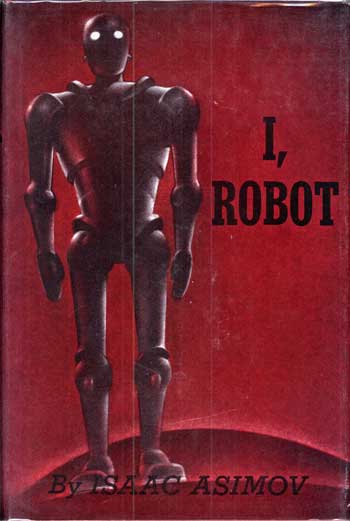
Instead, I’d like to draw attention to a particular aspect of Isaac Asimov’s writing, of which I can’t help being reminded after reading these reports. As the father of the term “robotics” and all things relating to it, Asimov dealt with nearly all of the issues relating to artificial intelligence. A few of his fictional robot characters even developed human-like, self-aware consciousness and creativity. But the one thing which stands out about these characters was that their consciousness was rarely a design of their creators, but rather a fluke. Minute variations in the mechanized construction of their positronic brains amounted to unique, creative minds.
Asimov’s choice to author conscious robots as results of random chance forces us to think about how human consciousness evolved in reality. It may be that such a consciousness is not strictly required for an organism to dramatically enhance its chances of survival and reproduction. We seem to assume that our superior cognitive abilities grant us an enormous advantage over other species, that the sort of consciousness which makes us self-aware, reflective and creative was the “end result” in a very long line of brain development. But evolution does not work towards such a specific end. There are plenty of other species (e.g. viruses) that persist with just as much vigor as us, despite their lack of cognitive powers associated with the forebrain. Perhaps only a minor, random mutation resulted in a dramatic and permanent change in the brain, a change which ultimately amounted to consciousness. Who knows what the odds are that such an intelligence evolved, or will evolve again in a computer simulation? At least we can be reassured that, on a long enough time scale, even the most unlikely event can occur.
In any case, Boston University’s own Isaac Asimov has made many a prediction with his science fiction, and many more can be expected.
“Artificial life forms evolve basic intelligence”-Catherine Brahic
“Could I ask everyone to please take their seat? The Memory Ensemble will begin momentarily.”
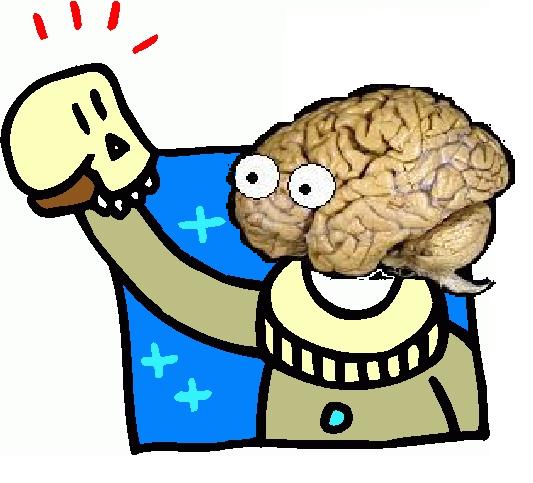
If I told you that a theater company and a medical school collaborated to produce one of the best plays of the year, would you believe me?
Probably not, because this is not the case. However, this unlikely partnership of industries did produce a substantial therapeutic program for people who are currently suffering the cognitive deficits associated with dementia.
Based on the theory of cognitive reserve - or the brain’s resilience to neuropathological damage - it is widely hypothesized that creative and interactive activities, such as painting, singing, and acting, would help patients maintain their cognitive functions for as long as possible.
With this hypothesis and the guidance of the Lookingglass Theater Company, the Feinberg School of Medicine at Northwestern University formed the first-ever "Memory Ensemble." The cast included six elderly patients suffering from early stages of memory loss, a common symptom attributable to various types of dementia.
Quoted as “one of the first-of-its-kind," the directors of this production sought to design a program that would improve the quality of life for these patients by setting up a safe and supportive environment. With the serene scene set, patients were encouraged to express every emotion and/or words associated with their neurological deficits to help them alleviate any pains or questions of uncertainty accompanied by these disorders.
As a part of a seven week pilot study, the ensemble would meet and participate in various cognitive activities, including an impromptu-style of acting that actively engaged the patients both physically and mentally. As a baseline measure, metaphor-based warm-up exercises prompted the patients to choose a color that symbolizes their current emotional state. Prior to their regularly scheduled regime, the patient’s reports ranged from a happy sunny yellow to a melancholy blue. Nevertheless, after a stretching routine, body-sculpting exercises portraying various feelings, and an active discussion of the hardships involved with their disorders, all of the patients were quick to describe their emotional state at the end of the workshop as a happy yellow.
Although these patients verbally reported an improvement in their quality of life within the given time period, it was noted that this qualitative research study could not quantitatively provide evidence in support of their hypothesis. Thus, a lack of evidence from this study could be detrimental to implementing this therapeutic program in hospitals across the US simply because of the lack of funding.
Though not discussed in this article, pre- and post-study fMRI scans and intermittent neuropsychological tests could provide quantitative insight on whether or not such a therapeutic program significantly contributes to the patient’s cognitive reserve. Pre- and post-study fMRI scans of the patients performing these neuropsychological tests can be compared to control subjects, as well as across-patients and within-patients, in order to identify the statistical differences between the patterns of activity associated with each task. Other measures, such as reaction time, can also be recorded to correlate with the patients behavioral performance to provide more information and insight on whether or not this is an effective prevention program.
Despite this predicament, I must say that I am very impressed and optimistic about this new style of therapy because it helps the patient positively cope with such a disastrous and unfortunate mental disorder. In the future, I hope that quantitative measures, as discussed before, will be implemented to help facilitate and disambiguate the uncertainty pertaining to dementia-related research.
Trying Improv as Therapy for Those with Memory Loss - Chicago News Cooperative - NYTimes.com
Cognitive Reserve - Dr. Yaakov Stern (2009) - Neuropsychologia (PDF)
Why Did You Choose to Read This?
FoxTrot by Bill Amend
The Stone (a philosophy-oriented opinion column in The New York Times) recently published two arguments related to free will. On July 22, Galen Strawson, a professor of philosophy at Reading University, presented the idea of determinism to his readers. In short, determinism is the idea that everything is causally linked to prior events. Because one cannot control the infinite influences of genetics, culture, and history, it is impossible for one to declare that one has free will. The choices that a person makes depends on an innate selection of preferences that a person already has, and that innate selection of preferences also depends on another set of preferences, and so the sequence regresses. Strawson agrees that this "reality" about the universe does not change anybody's opinion about free will and one's responsibility felt towards one's actions (he includes himself as an ultimate disbeliever), but simply believing free will is real does not make it so.
However, the Stone published an opposing argument on July 25th – a mere three days later. Before readers could wrap their minds around Strawson’s theory about free will, William Egginton, a professor at Johns Hopkins University, presented the fact that free will is at the forefront of everyone's lives. Egginton explains that humans have a tendency to explore beyond what their senses can understand. This trait is good since we as a species have grown to understand more about our surroundings, but this quality also leads to projection and sensationalism among us. People are quick to make assumptions and draw conclusions about facts presented to them. For example, the New York Times itself sensationalized a “finding” of dark matter when in reality, the “discovery” was no more important than levels of dark matter found by accident.
Egginton described an experiment where monkeys "were taught to respond to a cue by choosing to look at one of two patterns." The computer that was hooked up to the monkeys then determined the decision the monkeys were about to make a few fractions of a second before the monkeys' eyes looked at the pattern. The scientists declared that because the monkeys were not taking time to weigh any options, the computer could predict the decisions that the monkeys were about to make.
Egginton asks, but were the computers really able to predict such decisions? Egginton argues that these computers were not predicting decisions; they were merely presenting the neural processes that led up to the monkeys making decisions. This makes sense if one considers the processing speed of computers. They generally perform functions (especially simpler ones) faster than human brains do. One could guess that these computers also work faster than monkey brains, so the computer was just offering the processes faster than the monkey. It was not extrapolating what the monkey would do before it would do it; it was only giving a readout of what the monkey had already decided a little bit faster than the monkey itself. No decisions were technically being made by the computer for the monkey.
Egginton finishes by saying that humans have free will whether they like it or not. They are prisoners of freedom not because they can choose but because they must choose.
However, these two arguments have left me feeling dissatisfied. Although I'm a believer of free will (I love Sartre), I can't help but think that both of these arguments sit on extreme ends. I'm assuming the editors at The New York Times wanted these arguments to be this way, so readers could make choices of their own about their free will.
My father has always told me that life is about balance. As a result, I try to rationally balance everything that I do, say, or think. I would say that a human's ability to have free will and live freely because is a combination of determinism and free will itself. In addition to humans having a tendency towards fanaticism by projecting their knowledge onto simple facts about the universe, humans also like to categorize and rationalize things such that they make the most sense for their own lives (I'm doing it, too!).
For example, when two people are breaking up, one of the partners may say that the breakup was inevitable while the other partner says that he or she had no idea that the breakup was coming. The partner that said the breakup was inevitable would most likely say that the breakup was a sensible thing to do, while the other partner would probably say that the breakup was random and unexpected. The person who views the breakup as a surprise will most likely feel more pain and mourn the end of the relationship more than the person who saw it coming. Despite the fact that these two people are undergoing the same breakup, they rationalize the events as determined or random depending on their point of view. The way they rationalize correlates directly with the way they choose to cope with the breakup.
For some people, saying that a higher power like determinism or even God essentially makes decisions for them makes their lives easier because they don't want to be held responsible for some of their personality traits or actions. For others, saying that they have free will and must make decisions all the time makes them feel better because they will feel like they've done all they could to change a situation when they fail or succeed. Many feel at peace when they "know" that their choices have made them who they are.
I can't say that either side is right or wrong, but life must be more nuanced than either argument says it is. At times, I feel as if certain choices I have made have definitely influenced what I've done or why I feel one way or another about a scenario. But other times, I don't think that anything I could have done would have changed what happened to me. Sure, if I fall down when I'm walking down some stairs, I certainly could have done something else, but why does that matter? For situations like that, I think that it doesn't really matter if your free will did or didn't cause that situation. It happened regardless of what caused it. That is what is most important.
We like to ruminate on how what we did affects what happened, but it seems that we need to be spending more time thinking about how what we do now will affect how we are in the future.
What do you choose?
Your Move: The Maze of Free Will - Opinionator Blog - NYTimes.com
The Limits of the Coded World - Opinionator Blog - NYTimes.com
Extra extra!!! Storm brewing in espresso shot!
The media is always hungry for juicy stories about anything. Topics of interest range from Lindsey Lohan's latest adventures to the implications of another political ethics violation. The science writers at the New York Times are no exception. Dennis Overbye confessed in an essay yesterday that some writers are so eager to report on sensational findings that they sometimes hype up their stories.
Shocking! Overbye gives an example of one such NYT article, which reported the amazing story that scientists found hints of the elusive and mysterious dark matter in a Minnesota mine. He said the article raised a hysteria, but it eventually left people disappointed when someone cared to report that the amount of dark matter found was not far above amounts found by chance. Dennis Overbye goes on to condemn the internet for spreading rumors, but he fails to note that the original hyped report on dark matter was written by him!
Perhaps our trusted science writers should do a bit more research before they publish their articles. But wait! they need the stories, and they need those stories to be catchy, damnit! Their job isn't to educate readers on the current state of whatever scientific field; their job is to report the latest findings. They more controversial they are, the better. There's a new article everyday about how exercise is good for you (or is it bad? I can't remember anymore) or how prostate or breast exams for cancer have been wrong all these years (don't worry - they'll turn out to be right again next week). No wonder Americans are confused about their health.
Individual studies are great, but they have to be taken in context and have to stand the test of time. Most findings in basic science research are small; it's the knowledge collected over many experiments and years that gives us a big picture of any one field. So the next time you read about "a new study," take it with a critical grain of salt.
Engineering the Blind to See
Vision is one of the most impressive functions of the human brain. It interprets nothing but electromagnetic waves and paints a glorious picture of our daily existence from the scattered chaotic sea of intertwining light waves that we call home. Many see their vision deteriorate and the world blur as time goes on and these problems can be corrected by optometry, but blindness comes on like a relentless infidel for more than two million people worldwide in the form of retinitis pigmentosa (RP). RP is a heritible genetic disorder that leads to degeneration and loss of function in the retina's photoreceptor cells, and can lead to full blindness in a matter of years. There is no cure or treatment for RP, but new research may change that very soon.
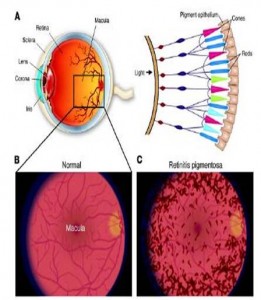
TOP: Macroscopic human eye (left) and rod and cone cell arrangement on the retina (right). BOTTOM: Normal human retina (left) and human retina with retinitis pigmentosa (right)/(Source: Medical-Look.com)
Vision starts in the photoreceptor when light activates rhodopsin, a G-protein coupled receptor pigment consisting of light sensitive opsin and retinal. Light triggers a conformational change in retinal that kick starts a G-coupled visual cascade and the flow of visual information to the brain. In retinitis pigmentosa, rhodopsins in the photoreceptors become insensitive to light starting in the rod cells, and blindness sets in gradually. Rod cells are used in low light and deteriorate first, leading to night blindness, and dysfunction in cone cells used for color vision and acuity sets in until full blindness plagues the individual. Fortunately, a team of French scientists has investigated this degradation and has found a way to combat it by reactivating the photoreceptor cells through genetics. Their study was featured in the July 23rd issue of Science.
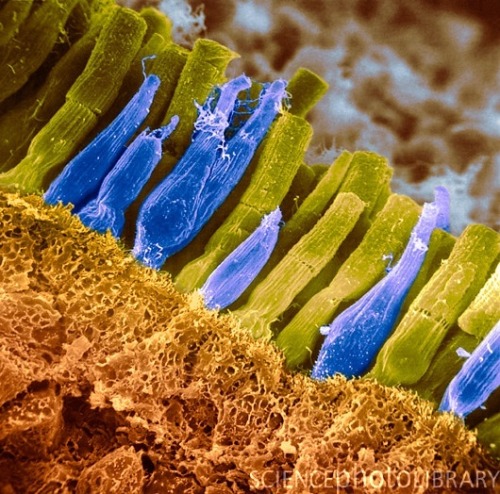
Artificially colored micrograph image of retinal rods (yellow-green) and cones (blue). (Credit: Science Photo Library @ sciencephoto.com)
The scientists isolated an achaebacterial rhodopsin analog called halorhodopsin that functions in the yellow and green wavelength range. They then introduced a halorhodopsin encoding gene into retinitis pigmentosa model mice via a viral vector and also created a control group. In their experiments, it was found that both slow and fast degrading retinal cells in the experimental mice regained their light sensitivity in response to integration of halorhodopsin into their insensitive photoreceptor cells. Electrical responses were recorded from ganglion cells (the third tier cell in the visual cascade) and healthy photoreceptor spikes were observed in response to light stimulation. Most importantly, lateral inhibition (the mechanism by which the brain discriminates edges of objects) was fully preserved, while mono-directional movement was retained. Halorhodopsin mice also performed significantly better than the control RP mice in a battery of visually guided tasks, demonstrating that their photoreceptors had been successfully resensitized by halorhodopsin integration. The scientists also tested the resensitizing ability of halorhodopsin on cultured human retinal cells. They were successful in integrating halorhodopsin into human cells via viral vectors, but could not conduct any clinical trials. However, photoreceptors expressing halorhodopsin demonstrated photocurrents and photovoltages that would be adequate to restore human vision.

Theoretical device that allows a halorhodopsin treated patient to see by projecting patterned light onto the eyes derived from camera input. (Credit: Y. Greenman/Science)
This opens the door to treatment of retinitis pigmentosa in the genes - the same place where it starts. Although halorhodopsin therapy will not fully restore all wavelengths in human vision, it can still serve as a tool to bring restore vision in the blind through optical devices. For example, an RP patient could be treated with halorhodopsin gene thearpy, then outfitted with a device that images the visual field and translates it into halorhodopsin recognizable wavelengths. This light mosaic is then projected onto the patient's eyes and the can "see" what is in front of them. The supplied image of the device is from a perspective article in the beginning of the current issue of Science.
View the full text Science article here (HTML) or here (PDF) and the perspective piece about the article here. Be sure to discuss in the comments!
Sources:
Seeing the Light of Day - Science (Perspective)
Genetic Reactivation of Cone Photoreceptors Restores Responses in Retinitis Pigmentosa - Science (Research Article)
In Love With Love
Whether from real life, opera, books, or pop songs, we are all familiar with the act of falling in love. We have, perhaps, laughed at those who perform nonsensical or self-destructive acts in the name of love not even requited. It’s no wonder it’s been called insanity or even a disease. Neuroscientists at Stony Brook University are elucidating the chemistry of Cupid’s poisoned arrowhead.
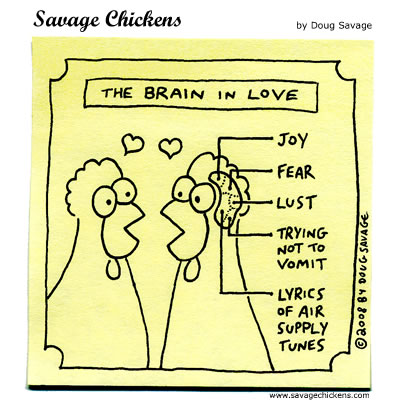
A recent study published in The Journal of Neurophysiology indicates that the feeling of love, and the person who elicits it, activate brain areas similar to that of drug addicts. The feeling also triggers dopamine release related to motivation and reward. It seems that love is a goal-oriented motivation instead of merely a feeling.
A study conducted at Stony Brook University included 15 heterosexual female and male individuals who had recently broken up with a loved one but claimed to still be deeply “in love” with that person. They experienced what they described as constant pain and anguish, and they were particularly miserable when reminded of that person. The anguish bears many similarities to withdrawal. Extreme behaviors such as suicide, stalking, and homicide represent extreme cases of seeking recompense for the lost addictive object; these behaviors mimic those exemplified in of cocaine addicts. Furthermore, stimuli reminiscent of the lost lover, such as photos, exacerbate a craving similar to that of addicts longing for a return of their opiate.
The fMRIs possibly confirmed what was qualitatively observed. Participants were first shown a photo of the loved one, then asked to complete a math exercise to distract them, and then finally shown a picture of a neutral individual. Several significant areas lit up further when shown the picture of the loved one as opposed to the neutral individual. One of the areas more strongly activated was the ventral-tegmental area in the midbrain, which controls motivation and reward, and has been continuously correlated with feelings of romantic love. Other areas were the nucleus accumbens and orbitofrontal/prefrontal cortex, areas both associated with craving and addiction, particularly the dopaminergic reward system activated in cocaine addiction. Also activated were the insular cortex and anterior cingulate, centers involved in physical pain and distress.
Concerning the study, Dr. Arthur Aron states that “it shows that intense romantic love seems to function much like an addiction… But that does not tell us one way or the other whether the desire to be in love in general is an addiction.” However, it seems likely to me, that so long as we are drawn to the pleasurable, we can develop an addiction to it. Many of us have witnessed, I’m sure, certain individuals tending toward frequent infatuation or crushing. Those who seem to be in love with love.
Dr. Aron believes the study will not only bring insight into the enigma that is love, but help to treat those with addiction later. The study also brought consolation to its participants, revealing the aphorism “time heals all wounds” to be scientifically warranted. As time passed, an area of the brain associated with attachment, known as the right ventral putamen/pallidum, reacted less and less over time to a photo of the loved one.
Love, of course, is a many faceted diamond. Infatuation is but one of its angles, though it is the most sparkly and attractive, and it is usually what first catches the eye. Relationships involve an intricacy of emotions and motivations that are never static. However, the study seems to illustrate a truth concerning the self’s pleasure or reward that defines one of the key aspects of this poetic feeling.
Anguish of Rejection May Be Linked to Stimulation of Areas of Brain Related to Motivation, Reward and Addiction - ScienceDaily
Reward, Addiction, and Emotion Regulation Systems Associated With Rejection in Love - Journal of Neurophysiology
Down the Rabbit Hole: Alex Bellos' Alex in Numberland
I hereby request that you read the following excerpt from Alex Bellos’ Alex’s Adventures in Wonderland. However, I recognize that your choice to do so (or not to) is entirely up to you. You have one-hundred percent control. Either way, here it is:
“The human brain finds it incredibly difficult, if not impossible, to fake randomness. And when we are presented with randomness, we often interpret it as non-randomness. For example, the shuffle feature on an iPod plays songs in a random order. But when Apple launched the feature, customers complained that it favoured certain bands because often tracks from the same band were played one after another. The listeners were guilty of the gambler’s fallacy. If the iPod shuffle were truly random, then each new song choice is independent of the previous choice. As the coin-flipping experiment shows, counterintuitively long streaks are the norm. If songs are chosen randomly, it is very possible, if not entirely likely, that there will be a cluster of songs by the same artist. Apple CEO Steve Jobs was totally serious when he said, in response to the outcry: ‘We’re making [the shuffle] less random to make it feel more random.’ Why is the gambler’s fallacy such strong human urge? It’s all about control. We like to feel in control of our environments. If events occur randomly, we feel we have no control over them. Conversely, if we do have control over events, they are not random. This is why we prefer to see patterns when there are none. We are trying to salvage a feeling of control. The human need to be in control is a deep-rooted survival instinct. In the 1970’s a fascinating (if brutal) experiment examined how important a sense of control was for elderly patients in a nursing home. Some patients were allowed to choose how their rooms were arranged and allowed to choose a plant to look after. The others were told how their rooms would be and had a plant chosen and tended for them. The result after 18 months was striking. The patients who had control over their rooms had a 15 percent death rate, but for those who had no control the rate was 30 percent. Feeling in control can keep us alive.”
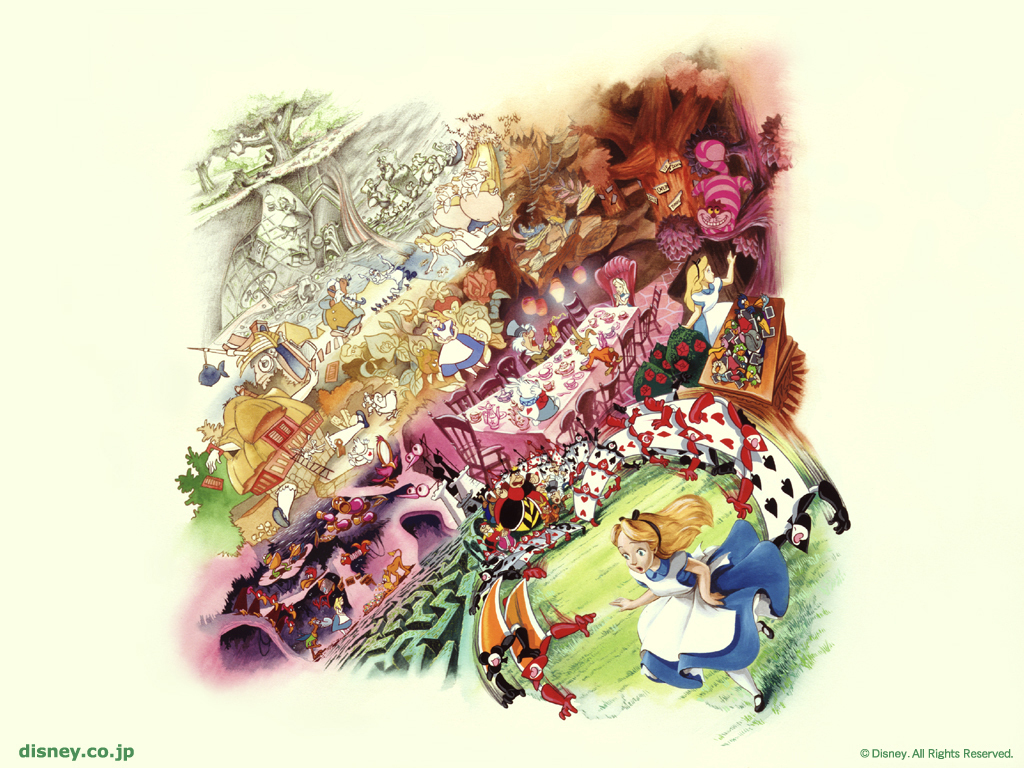
Alex in Numberland possibly even more mad than Alice in Wonderland?
Bellos is a British writer and broadcaster who studied mathematics and philosophy as an undergraduate (so his sweeping conclusions might be a little dramatized with pretty flourishes for emphasis, but seem worth mulling over for a couple minutes on a long summer day).
Bellos grazes over several points in these two short paragraphs: Our ability to find patterns where there are none, our comfort with patterns, our constant grasp at control through patterns, and the emotional support that control gives. Many neuroscientists would argue that any control we enjoy is all a mirage; every decision and thought is predetermined despite the turmoil we feel when making a decision. But if that is the case, why does picking the khaki shorts over the denim or “one vente, skinny, extra hot, double shot frappawappacino with whip, please” feel so right? If our decisions have all been made for us - and we are just speaking for the desires of our neurotransmitters -why would the illusion of control give us such comfort? Why would it double the survival rate of elderly patients? If my brain has carefully calculated all of my decisions from now until forever, why did we develop so that control feels so good?
In any case, a gold star to Steve Jobs for making the shuffle option less shuffle-y. Gambler’s fallacy, shmambler’s fallacy - I know my iPod was starting to show a clear preference for Queen.
All About Empathy
What contributes more to creating a person’s identity (i.e. personality, behavior, intelligence)? Is it genetics, or is it the environment in which the person was raised? In other words, as Francis Galton might ask, is it “nature” or “nurture?"
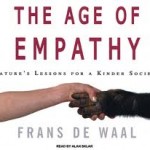
de Waal's book on empathy
When it comes to how empathetic someone is, Frans de Waal, a Dutch primatologist and ethologist, believes it’s both nature and nurture. He says that a person’s empathy is “innate” – inherited through genes – but also that a person can learn to become more or less empathetic. That seems reasonable; depending on early experiences and education, someone may be more or less of a certain characteristic.
But how is empathy innate? Two NewScientist writers, Philip Cohen and Ewen Callaway, wrote articles discussing the areas in our brains called the anterior cingulate cortex (ACC) and the anterior insula (AI), which become active not only when we are in pain but also when others are.
Imaging studies, cited in their articles, found a positive correlation between a volunteer’s reported empathy for a person in pain and activity in the pain-processing areas of the volunteer’s brain. This has led Cohen to believe, “Humans are hardwired to feel empathy.”
For example, in a study led by Shihui Han and colleagues, “17 Chinese and 16 Caucasian (from the US, Europe and Israel) volunteers” were shown videos of strangers, both Caucasian and Chinese, in pain while their brains were scanned using fMRI. While their fMRI results suggested that they responded more empathetically towards volunteers of the same ethnicity or from the same country, their responses actually indicated they “[felt] each other’s pain about equally.”
Interestingly, our brains seem to be “hardwired” to feel more for certain groups over others, whether we notice or not. These groups appear to consist of people we can identify more with, whether through ethnicity, age, gender, or any other in-group.
Frans de Waal would find these results quite understandable. He says, “Empathy is more pronounced the more similar you are to someone, the more close, socially close, you are to someone.” He continues to say that empathy “evolved… for members of any species that is cooperative and social... it’s important to take care of others in the group because you depend on [them], you survive by [them].”
Seemingly then, our brains, and likely those of other species, have evolved to serve a survival advantage; they respond in those pain-processing areas more actively when those like us are in pain, despite what we report as our level of empathy.
While we seem to be hardwired to empathize more with certain groups over others, we’re still united as a species to empathize with one another over those of other species.
Martha Farah, a cognitive neuroscience researcher, suggests that we have a “person network” divided into persons and non-persons, which has promoted closer social bonds within our species. Farah proves that this brain network exists by considering the rare disorder prosopagnosia, which consists of “impaired visual recognition of the human face.” A specific area of the brain can be “selectively” damaged for one to obtain the disorder, demonstrating that specialized areas of the brain exist for discerning other humans.
Whether our brain also specializes in empathy towards non-persons is something to look into. For now, consider yawn contagion, which de Waal discusses with TIME about. He says there is a “deep bodily connection” that allows pets to catch yawns from their owners. This seemingly innate connection seems to break physical barriers with other animals, but what, if any, connection breaks emotional ones? And is it innate, or is it learned?
Have animal rights activists and pet lovers learned to be more empathetic towards non-persons? I’d like to think that it’s not just the influence of my environment that has led me to empathize with my childhood pets or toys – not to mention some of my favorite characters, like Hamm from Toy Story or Patrick from SpongeBob SquarePants.
Whether it is learned, innate, or both, I cannot say, but anthropomorphism seems to explain our emotional connections with non-humans. It breaks the barrier, allowing us to personify or add human characteristics to non-humans. For example, most people would probably like to think of their childhood pets as loved ones with human-like feelings and desires. However, would some stranger halfway across the world feel the same way you do about your pet? Probably not. They’d likely think of it as just another animal, simple as that.
 Most people, if asked if they support animal rights, would probably answer ‘Yes’ or some derivative
Most people, if asked if they support animal rights, would probably answer ‘Yes’ or some derivative of that. But, would they promise to never buy any animal-based products (eggs, meat, suede, leather, or even the chinchilla coat seen on Teresa last week in The Real Housewives of New Jersey)? Most likely not. I mean, for anyone, that’s a hard promise to keep when we have other priorities.
of that. But, would they promise to never buy any animal-based products (eggs, meat, suede, leather, or even the chinchilla coat seen on Teresa last week in The Real Housewives of New Jersey)? Most likely not. I mean, for anyone, that’s a hard promise to keep when we have other priorities.
So how do we go from talking to our pets as if they were humans to absentmindedly buying products that might contain ingredients of an animal just like our pets?
de Waal says we do this through dehumanization. We go about anthropomorphizing our favorite pets, toys, and characters just as we go about dehumanizing them. By removing human characteristics, like emotion or spoken language, we don’t have to feel as bad about buying that leather jacket we always wanted. de Waal reminds us, “We eat nonhuman animals, wear them, perform painful experiments on them, hold them captive for purposes of our own – sometimes in unhealthy condition. We make them work, and we kill them at will.”
So, the next time you shop and find that animal-based product you just NEED to buy, take a second to think about how you’re setting your priorities. Think about how, maybe unconsciously or unintentionally, you are dehumanizing the animals used for the creation of the product you’re about to buy. Couldn’t that animal be from the same species as your favorite TV character, or even your old pet? I think so, easily.
Sources:
Are Humans Actually Selfish – Time
Learning Empathy From Apes – KPBS
Brain's response muted when we see other races in pain – NewScientist
Humans are hardwired to feel others' pain – NewScientist
Primates and Philosphers: How Morality Evolved – Google books
Dream Bigger, Darling.
As my good friend Cobb once told me, “Dreams feel real while we’re in them. It’s only when we wake up that we realize something was actually strange.”
OK, fine, Leonardo DiCaprio’s character from Inception isn’t real, but he does make a valid point. Oneirologists, those who study dreams, have traditionally viewed dreams as uncontrollable streams of sounds and images with the ability to induce a tremendous spectrum of emotion. However, the idea of lucid dreaming has caused the conventional understanding of dreams to collapse. A “lucid dream," terminology coined by the Dutch psychiatrist Frederik van Eeden, is one in which the sleeper is aware that he or she is dreaming. This example of dissociation is wonderfully paradoxical in that it exhibits components of both waking and dreaming consciousness.
An American psychiatrist and dream researcher named Allan Hobson specializes in the quantification of mental events and their corresponding brain activities. Although he vehemently dismisses the idea of hidden meanings in dreams, he has embarked on a search along with other neurobiologists and cognitive scientists to decipher the neurological basis of consci ousness. Hobson hypothesizes that subjects may learn to become lucid, self-awaken, and regulate plot control by intercalating voluntary decisions into the involuntary nature of the dream.
ousness. Hobson hypothesizes that subjects may learn to become lucid, self-awaken, and regulate plot control by intercalating voluntary decisions into the involuntary nature of the dream.
The validation of this idea would imply that the mind is capable of experiencing a waking and a dreaming state at the same time. Consequently, Hobson states, “…it may be possible to measure the physiological correlates of three conscious states, waking, non-lucid dreaming, and lucid dreaming in the laboratory.” If there is a psychological distinction between the three, there should also be a physiological difference.
The advent of lucid dreaming experimentation has not only benefitted Hollywood, but it has also provided possible treatment options for those hindered by frequent nightmares or post-traumatic stress disorder (PTSD). Methodologically speaking, the study of lucid dreaming presents a formidable challenge, but it is becoming an important component of the cognitive neurosciences.
Josefin Gavie and Antti Revonsuo have built on Hobson’s theories by proposing a technique termed lucid dreaming treatment (LDT). The key to this treatment is that the subject learns how to identify cues that facilitate lucidity during a dream, and the subject learns to manipulate the environment once lucidity is attained. The phenomenon of lucidity may prove to be a useful device in that it offers the sleeper a method to control components of the dream - altering and diminishing any threatening situation. Although the investigation of LDT is extremely new and incontestably controversial, it has shown promising preliminary results in its ability to lower the frequency of nightmares in the selected subjects.
The premise of the film Inception may be wildly hypothetical, but it has expertly amplified the current research on lucid dreams. However, researchers in the field should take a word of advice from the character of Eames: “You mustn’t be afraid to dream a little bigger, darling.”
The Neurobiology of Consciousness: Lucid Dreaming Wakes Up - J. Allan Hobson
The Future of Lucid Dreaming Treatment (PDF) - Josefin Gavie and Antti Revonsuo




